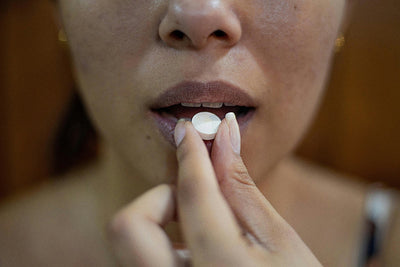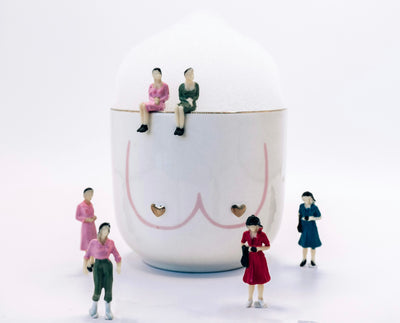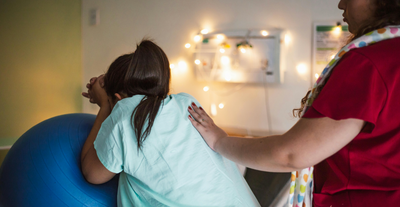Breastfeeding and 4 Types of Jaundice: When to Worry
Breastfeeding and 4 Types of Jaundice: When to Worry
by Jordan Berns
You can’t believe it; you’re finally going to be a mom! You’ve read all the books, taken every class, and set up your nursery to be just so. Sometimes, unfortunately, everything you’ve planned for your first few days postpartum doesn’t seem to go very smoothy. And perhaps, it feels like the very thing you were excited to nourish your baby with, breast milk, seems like it’s betraying you. Breast milk, while full of health-boosting antibodies, can occasionally cause problems such as infant jaundice.
Jaundice, especially the way it tints your baby’s skin and eyes yellow, can be scary for a parent. However, jaundice is pretty common and is usually not cause for concern. In fact, 60% of full term babies and 80% of preemies tend to get it.
What causes jaundice and how is it treated?
The color change associated with jaundice is from elevated bilirubin levels. Bilirubin is a product of red blood cells breaking down. Bilirubin travels through the body to the liver, where it’s stored in the bile duct, eventually being excreted as stool and urine. Everyone has a dash of bilirubin in their bodies, but people only begin showing the physical symptoms of jaundice when levels reach 2 to 3 mg/dL (milligrams per deciliter). Babies and those under 18 usually have 1 mg/dL bilirubin in their system. Bilirubin is a water soluble compound, which makes it fairly harmless. However, it can become “unconjugated,” meaning that it’s too molecularly heavy to pass through the kidneys and leave the body.
The four main types of jaundice are breastfeeding jaundice, breast milk jaundice, psychological jaundice, and blood group incompatibility.
Breastfeeding Jaundice:
Breastfeeding jaundice is seen in 5 to 10% of babies and generally shows up when they’re around two or three-days-old. It tends to disappear in one to two weeks. This specific type of jaundice is usually seen when babies don’t get enough milk. A lack of breast milk can lead to a delay in the excretion of the meconium. Meconium (the coating of babies’ intestines in pregnancy) makes up a baby’s first bowel movement. If this bowel movement is significantly delayed, the bilirubin may again be absorbed by the intestines. While the reabsorption of meconium can be dangerous, breastfeeding jaundice is usually considered benign.
Breastfeeding jaundice is best remedied by breastfeeding more often, usually every two to three hours (even if you have to wake your baby to nurse). A common reason babies are underfed is due to latch issues. Have a chat with your lactation consultant to remedy this hiccup.
Breast Milk Jaundice:
“Breastfeeding jaundice” and “breast milk jaundice” sound like they’re the same thing, but they are actually quite different. Although science is advanced, there’s still much we don’t know about breast milk jaundice, like how babies get it in the first place. It’s believed that breast milk jaundice could be a result of something in breast milk that alters a baby’s normal liver function, but data has yet to be conclusive. Additionally, some believe this type of jaundice to be hereditary.
Breast milk jaundice is rarer than breastfeeding jaundice; occurring in 1 to 2% of babies. This condition usually presents itself anywhere from four days to one week postpartum. Breast milk jaundice tends to last longer than breastfeeding jaundice, but it’s generally deemed to be harmless.
There are many ways to treat this type of jaundice. One solution is briefly supplementing or replacing the mother’s milk with formula or donor milk. Another cure may be a light-based treatment called phototherapy. A blue light (commonly from a Bili-blanket or Bili-light) shines on the baby, transcending through the skin, and breaks down bilirubin into smaller fragments that can more easily be passed. Phototherapy may cause persistent, watery stools, so it’s important to make sure your baby is hydrated; extra nursing sessions might be needed. Phototherapy treatments can range from 24 hours to 7 days. Eye damage is not generally associated with blue light, but in the interest of safety, all babies are given eye protection.
Psychological Jaundice:
Psychological jaundice is the most common, accounting for 50% of cases. This type of jaundice shows up two to three days postpartum. Psychological jaundice is common when babies are born with livers that just need a little extra time to mature. Phototherapy can help treat this, but indirect exposure to sunlight may also work. This is probably the safest type of jaundice. Still, it’s best to keep a watchful eye over your baby’s symptoms and make sure they are getting sufficient nourishment.
Raising babies and raising concerns: when jaundice is dangerous.
Blood Group Incompatibility Jaundice:
This type of jaundice may develop when a breastfeeding baby and mom have different blood types, especially if they have mismatched ABO or Rh blood types. One of the great things about breast milk is that mother can pass on antibodies to her baby. Sometimes, however, a mother (through no fault of her own!) has antibodies in her breast milk that attack her baby’s red blood cells. This is a more serious type of jaundice that usually presents itself on the first day of a baby’s life. Rh cases are the one to be most concerned about, as it causes the worst incidences of jaundice. In this particular situation, the cure is partly preventative. Mothers, when given a shot of RhoGAM during pregnancy or within three days of birthing her baby, can help stop the production of the destructive antibody.
When to Worry:
More often than not, jaundice only requires a little extra care and patience. However, there are some exclusions to this rule, like hyperbilirubinemia or kernicterus. Hyperbilirubinemia is when bilirubin levels jump too high, too quickly. In this event, blood tests could be needed. In very rare or serious cases, an exchange transfusion might be necessary. Kernicterus is a condition where an excess of bilirubin forms and spreads to the brain tissue, imparting permanent damage. Kernicterus attacks the hippocampus; basal ganglia; geniculate bodies; and cranial nerve nuclei (like the cochlear, vestibular, and oculomotor). Some, but not all, of the symptoms of kernicterus include lethargy, a body that is limp or arches like a bow, high-pitched crying that cannot be soothed, fever, vomiting, not passing bowel movements or urine, and the reduced desire to eat.
An important thing for breastfeeding mothers who have jaundiced babies to remember is that none of this is their fault or means they’re bad parents. Sometimes babies get jaundice, but with careful love and attention, this condition can fade away as quickly as it arrived. A key job for parents in this scenario is to keep track of their little one’s stools and appetite. To help with this, Lactation Lab offers a free app called Emily (for iOS and Android) that tracks feedings and the frequency and consistency of babies’ stools, amongst other things. Keeping an accurate log of this information can help you and your doctor make the best, most informed decisions possible and get your baby on the road to recovery.






